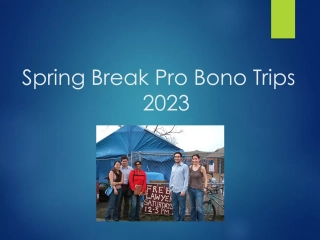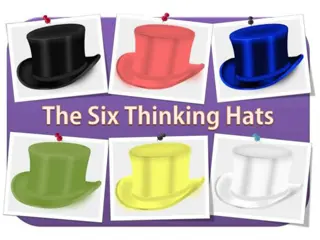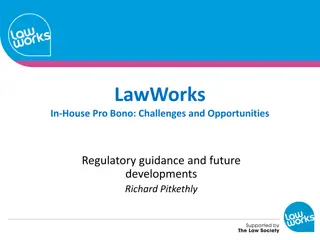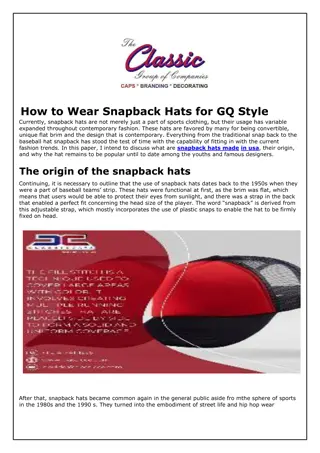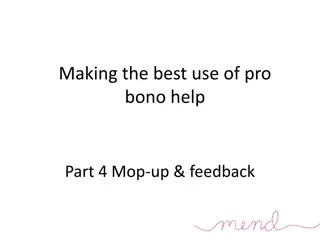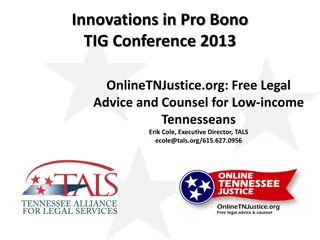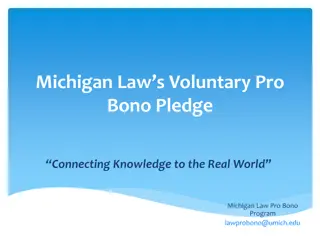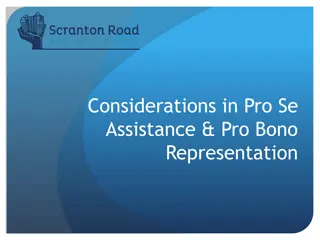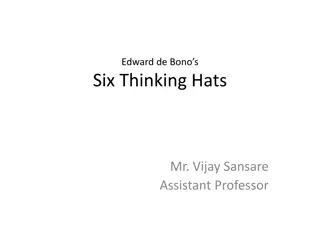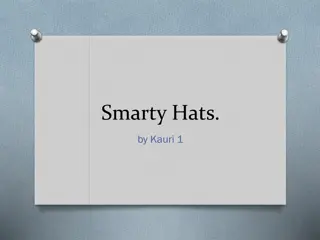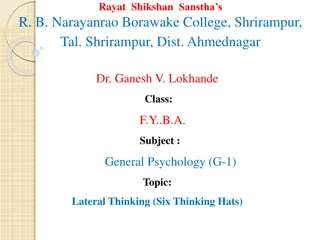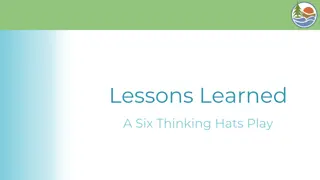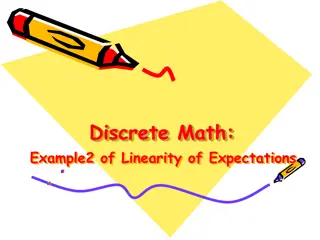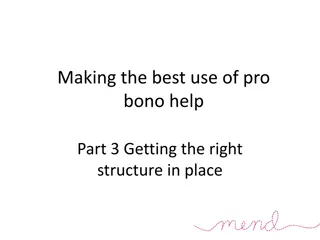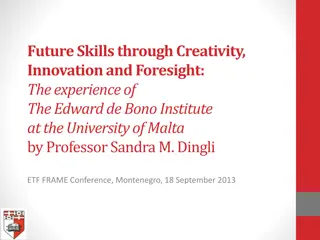Exploring Creative Thinking with de Bono's Six Hats Framework
"Discover the innovative approach of de Bono's Six Hats for creative thinking, which involves wearing different 'hats' to explore ideas and provoke unconventional thoughts. Learn how to generate and build off ideas through exercises like C-Sketch and provoke radical ideas with Provocative Operations. Dive into examples like planes flying upside down and challenging assumptions to stimulate creative solutions."
Download Presentation

Please find below an Image/Link to download the presentation.
The content on the website is provided AS IS for your information and personal use only. It may not be sold, licensed, or shared on other websites without obtaining consent from the author. Download presentation by click this link. If you encounter any issues during the download, it is possible that the publisher has removed the file from their server.
E N D
Presentation Transcript
de Bonos 6 hats A framework for creative thinking. Each hat is explored by an individual one at a time - you can t wear a purple (blue + red) had.
C-Sketch Each person gets a paper Divide the paper in three sections Spend 5-10 minutes generating 3 good ideas Record sketches [and words when necessary] Switch papers. Build off ideas for 5 minutes Repeat until everyone has worked on every sheet Process and discuss. You can put on different hats to move the discussion along.
Planes should fly upside down Initially sounds absurd wings would give negative lift! Movement leads to the idea of retractable winglets that, when deployed, generate negative lift (positive lift when upside down) This leads to the idea that these winglets would be normally deployed, but could be quickly retracted if a plane experienced a sudden loss of lift
Provocation Encourage statements that make no sense, might contradict known experience. Use as a stepping stone to a new idea (de Bono calls movement) The Provocative Operation is often referred to as a PO . POssible, hyPOthesis, supPOse, and POetry Provocation encourages you to unsettle your mind, unpack assumptions and propose radical ideas
Task: Method of Generating Movement PO Extract Difference Moment Positive Circumstance Escape Reversal Method of generating PO Distortion Exaggeratio n Wishful
Generating Provocations - Provocative Operations (PO) Escape Reversal Distortion Exaggeration Wishful Thinking
Provocative Operation escape Step 1: Describe something that you take for granted Step 2: Escape from that which you take for granted Watchdogs bark PO: Watchdogs that do not bark Movement: watchdog trained to press button triggering alarm and alerting authorities Restaurants have seats PO: Restaurants with no seats Movement: restaurant that charges for food and time spent
Provocative Operation reversal Step 1: Articulate the relationship between components/systems. Step 2: Modify cause-effect relationship, semantic relationship, flip roles Filters in cigarettes are there to remove tar PO: We add something instead of removing it Movement: Add air to dilute the harmful effects of the smoke I have orange juice for breakfast PO: The orange juice has me for breakfast Movement: I swim in orange juice, scented shower water The phone rings when I get a call PO: The phone rings constantly until I get a call Movement: indicator on phone showing it is live
Provocative Operation distortion Step 1: Articulate the normal sequence of events. Step 2: Change the order in the sequence of events. You pick up the phone before dialing PO: You speak before you dial Movement: voice activated dialing (exists) or record a complaint or order then have it replayed without having to say it You live before you die PO: You die before you die Movement: living benefits for life insurance policies
Provocative Operation exagerration Step 1: Consider something that involves measures, dimensions. Step 2: Exaggerate any one aspect (or dimension) of an initial statement making it somewhat unreasonable. Avoid exaggerating to zero (or it becomes an escape) PO: Telephone calls can only last two minutes Movement: compression capability so that you can talk at normal speed but utilize less equivalent line time PO: Police have six eyes PO: Telephones are too heavy to lift
Provocative Operation wishful thinking Express a wishful desire which is impossible to realize PO: All telephone calls are friendly Movement: green light on phone lights up when someone on friends list calls PO: You got paid for waiting to see the doctor (who is behind schedule) PO: The pencil writes by itself
Final thoughts on POs The more provocative the better Provocations should not be solution ideas or concepts (yet) avoid ideas fitting in Once we have a PO, it s time to look for movement!
Movement Extract a Principle Focus on the Difference Moment to Moment Positive Aspects Circumstances
Results from provocation Negative points may arise but do not focus on them; instead attempt to look forward Old ideas resurface there s no point in using provocation to generate old ideas; again strive to move forward to new ideas A feeling of something interesting is often a sign of potential Points of difference from the status quo may be worth exploring When value is found, always look for other ways you might achieve the same value
Results from provocation Many concepts normally result and they should be explored for practicality, combinatorial options, and strengthened where possible All resulting ideas should be documented for the record Sometimes a useful concept results Other times provocation yields nothing seemingly practical in that case harvest what you can learn from the failure and hope for better results next time!
Movement extract a principle Seek to extract a principle, concept, feature, or aspect of the PO (meaningful characteristics), then ignore the rest of the PO and work only with what you ve extracted to generate ideas Example: An ad agency was seeking a new medium -> PO: bring back the town crier -> Extract: oThe town crier can change the message based on audience oThe town crier can go where the people are oThe town crier can answer questions oThe town crier is always up to date oYou cannot switch the town crier off -> Movement: pay phones are free but calls are interspersed with ads
Provocative Operation focus on the difference Compare the provocation with the existing situation, identify the key differences, and pursue them Example PO: postage stamps should be long and thin -> Difference: length to width aspect ratio -> Movements: Length of stamp meters its value
Provocative Operation moment to moment Visualize the PO being put into effect moment to moment and seek to develop interesting new ideas. What would would happen if you actually did it? Examples: oPO: a car should have square wheels - > Moment to Moment: the axle rises and falls as the corners rotate around -> Movement: active suspension adjusts its height to give a good ride knowing when the corners are coming -> active suspension knows when bump is coming and adjusts accordingly oPO: Plane lands upside down -> Moment to Moment: pilot can see runway well while landing -> Movement: Concorde drops nose during landing for better visibility
Provocative Operation positive aspects Look directly for any benefits or positive aspects of the PO, take those benefits/aspects and try to move forward Example: PO: A car should have its engine on its roof -> Positive Aspects: ease of access for maintenance, shorter car, better airflow for cooling, less risk of engine damage in a collision, equal weight distribution -> Movement: a short, mid-engine car with the occupants seated above the engine
Provocative Operation circumstances Identify the circumstances under which the PO would have a direct value Examples: oPO: A car should have its engine on its roof -> Circumstances: in a flood the engine could still operate -> Movement: elevated intake to prevent water ingestion oPO: drinking glasses should have rounded bottoms -> Circumstances: Bars would sell more drinks, or no furniture rings since glass must be placed on special coaster
Methods for generating POs Escape: Pick something we take for granted and drop that Reversal: Take a normal relationship and reverse it Distortion: Make a change to the normal sequence or relationship Exaggeration: Exaggerate an aspect of a statement Wishful thinking: Wouldn t it be nice if Methods for generating movement Extract a principle: Extract a principle, concept, feature, or aspect of the PO, then ignore the rest of the PO and work only with what you ve extracted to generate ideas Focus on the Difference: Compare the provocation with the existing situation, identify the key differences, and pursue them Moment to Moment: Visualize the PO in effect moment to moment Positive Aspects: Look directly for any benefits or positive aspects Circumstances: Identify the circumstances under which the PO would have a direct value


